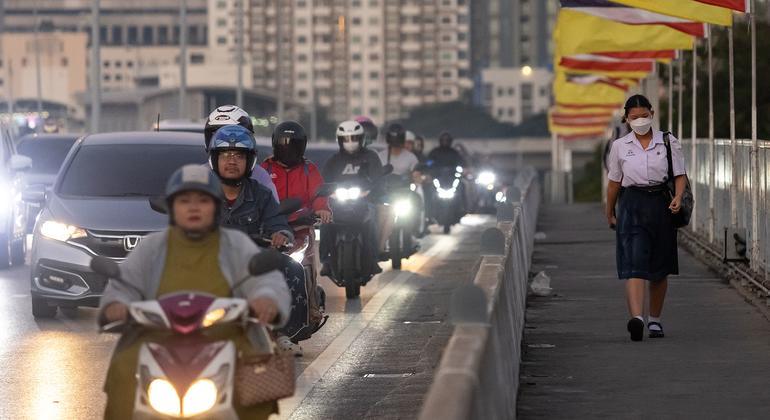The second WHO world conference on air pollution and health co -organized by the World Health Organization and Colombia, in the City of Cartagena, brought together more than 700 participants from 100 countries – including heads of state, ministers, scientists and civil society groups – to accelerate action to slow down what is more and more described as a health emergency at full diet.
“It is time to make commitments to daring actions,” said Tedros Adhanom Ghebreyesus, Managing Director.
“To achieve clean air, we need urgent actions on all fronts: financial investment in sustainable solutions, as in clean energy and sustainable transport, the technical application of global air quality directives and social commitment to protect the most vulnerable regions in our most polluted regions.”
The shared goal? A 50% reduction in impacts on air pollution health by 2040.
Countries such as Brazil, Spain, China and the United Kingdom have presented national roadmaps, while the Clean Air Fund has promised additional $ 90 million for climatic and health programs.
The cities that are part of the C40 network, including London, have promised to strengthen air quality monitoring and put pressure for more investment in pure air strategies.
A health crisis hidden in sight
According to the WHO, air pollution is responsible for seven million premature deaths per year and is now the second global risk factor of disease, after hypertension.
“Today, air pollution is the first risk factor in charge of the disease,” said Maria Neira, director of the environment, climate change and health. “This is the number one risk factor to get sick.”
The burden is the heaviest in countries with fast -growing cities and low regulatory managers. But Neira stressed that economic costs and health toll increase worldwide. “These chronic diseases cost us well-to our health system and our hospitals,” she said.
Despite dark statistics, WHO leaders say solutions are at hand. Neira has cited China’s progress in reducing emissions while continuing to grow economically. “At one point, they have shown that you can reduce air pollution while maintaining economic growth,” she said. “This argument according to which to fight against the causes of climate change, air pollution and environmental health, you must invest and you do not get any services immediately – it is not correct.”
Climate and health emergency
Indeed, air pollution is not only a public health problem, but a key engine and a symptom of the climate crisis. The combustion of fossil fuels which feeds air pollution also releases greenhouse gases – adding to global warming.
“The causes of climate change and the causes of air pollution overlap,” said Neira. “We have a lot to gain for health, economics and society, sustainable development, if we speed up this transition.”
She pointed out that clean air solutions – including renewable energies, the best urban design and the screening of fossil fuels – also serve as climate attenuation strategies.
“This pollution, this particles that we breathe every day … comes from different sources, but fundamentally from the combustion of fossil fuels,” she said. “This can only be avoided by accelerating the transition to more renewable energies; cleaner energy sources. ”
Examples of Colombia and Europe
Colombia hosts have presented a list of national initiatives, including cleaner fuels, zero emission public transport and a target to reduce carbon emissions by 40% by 2030.
“Air pollution requires more victims than violence itself. The poisoning of our air costs lives in silence – this conference strengthens our determination to implement policies for the environment and the health of our people, “said Colombia president Gustavo Petro.
He stressed the importance of smarter regulations and to fill the gap for inequality with indigenous peoples, local and rural communities.
In Europe, where air pollution still results in 300,000 premature deaths per year, legislators turn to stricter regulations. “Pollution is an invisible pandemic. It is a slowdown pandemic, ”said Javier López, vice-president of the Environment Committee of the European Parliament.
The European Union has recently adopted a new air quality directive, by half reducing legal air pollution thresholds and aimed at reducing the death -related deaths by 30% by 2030. “We have decided to propose the air quality directive, which is part of the European green package,” said López.
Regional model, global courses
Managers of the United Nations Economic Commission for Europe (UNECE) have also participated in Cartagena, highlighting the convention on long -range cross -border air pollution as one of the most successful multilateral environmental agreements to date.
“The Air Convention … is a multilateral environmental agreement which was adopted in 1979 to combat air pollution that crosses national borders,” said policy officer Carolin Sanz Noriega.
Since its adoption, the Convention has extended to 51 parts and has produced deep emissions in the region. “The reduction of sulfur dioxide emissions, nitrogen oxides from 40 to 80% compared to the 1990 levels in the region of one, and for more than 30% for particles,” said Ms. Sanz Noriega.
She stressed that the success of the agreement lies in its binding commitments, its robust sciences and its long -standing strengthening mechanisms. “The countries implement the convention because it really brings advantages. It provides health benefits, environmental advantages, benefits of cultures. She has co-avagnation for the climate. ”
Thanks to the forum for international cooperation on air pollution, it is now working with countries in Latin America, Africa and Asia to share scientific tools and regulatory approaches.
But a major challenge, especially in the world South, remains technical capacity.
“We have to make sure that countries can monitor air quality. This is the first step,” said Neira. “In Africa, unfortunately, we still lack a lot of surveillance capacity … You cannot manage what you cannot measure.”
Prescribe clean air
The health sector has provided one of the main points to remember from the conference. With millions of health professionals and people who already support the WHO campaign, the delegates have stressed that clean air must be recognized as at the heart of disease prevention.
“We have 47 million signatures from health professionals, patients, defenders, institutions, saying” I want to prescribe clean air, “said Neira.
“I do not want to treat patients with diseases caused by exposure to toxic air. I want to make sure that my patients will not be exposed and therefore they will not develop these diseases. ”
While the conference ended, the delegates left Cartagena embraced new partnerships, data and political options – but also a resounding moral imperative.
“Time to generate evidence [on air pollution] passed, “said Neira.” We have a lot. No one can say that they did not know.




